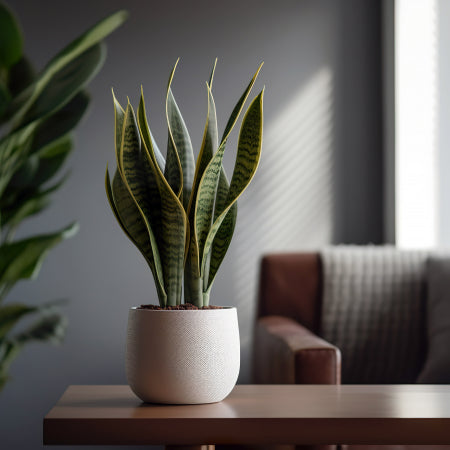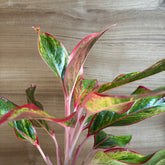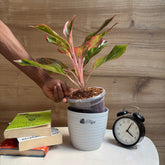Problems associated with Snake Plant and Solution
In the context of snake plants (Dracaena trifasciata), the leaves speak volumes, signaling pain or happiness. If you’ve seen your snake plant’s leaves yellowing, curling, or drooping, don’t worry; you’re not alone. This guide digs into common leaf concerns include yellowing, browning, curling, and drooping. Uncover the details, recognize the signals, and arm yourself with the knowledge to restore your snake plant. Let’s take a journey to learn the language of your snake plant’s leaves and cultivate a thriving indoor garden, from identifying the causes to applying solutions.
The Life Cycle of a Snake Plant
Before diving into the common issues and their solutions, it’s crucial to understand the life cycle of a snake plant. This knowledge provides a foundation for recognizing normal growth patterns and distinguishing them from signs of distress.
Growth Stages of Snake Plant
Snake plants are slow-growing and can take anywhere from 5 to 10 years to reach their mature size, depending on the species and growing conditions. They typically grow between 4 and 24 inches per year.
Under optimal conditions, Sansevierias can grow up to 2-3 feet high, with some varieties reaching even greater heights. Snake plants can be propagated from leaf cuttings, which usually take 3 to 4 weeks to root and 4 to 6 weeks to start growing.
Examples of Different Types of Sansevieria or Snake Plants
Here are few of the Different varieties of Sanevieria (Snake Plant)
- Futura Robusta: Grows to about 24 inches tall at maturity, with a spread of 12 inches.
- Futura Superba: Typically reaches 12 to 18 inches in height, with a maximum height around 24 inches.
- Zeylanica: Can grow up to 3 feet tall, but more commonly found at heights of 1 to 2 feet.
- Laurentii: Variegated leaves can grow 3 to 4 feet tall, at a rate of 4 to 12 inches per year.
- Moonshine: The broad leaves reach up to 2 feet in height and 3 to 4 inches in width.
- Black Coral: Slow-growing, typically reaching 30 to 40 inches in height.
Distinguishing Natural Aging from Problems
Differentiating between natural aging and potential problems is essential for providing optimal care. As snake plants mature, older leaves naturally yellow and may eventually wither. Recognizing these signs as part of your plant’s life cycle helps you avoid unnecessary interventions.
By discerning between normal aging and issues like disease or stress, you can tailor your snake plant care routine appropriately. This ensures a thriving and resilient Sansevieria that adds enduring greenery to your indoor space. Understanding this difference allows you to respond effectively, promoting the longevity and vitality of your beloved snake plant.
Snake Plant Leaf Issues: Reasons & Solutions
Let’s look into the snake plant leaf issues, deciphering the reasons behind common concerns like yellowing, browning, curling, and drooping leaves. Equip yourself with insightful solutions, empowering you to address these leafy quirks and ensure your snake plant thrives with vibrant, resilient foliage.
Yellowing Leaves in Snake Plant
Only feed your snake plant during the growing season (early spring to late summer).
If overfertilized, remove infected roots using sterilized scissors and repot the plant in fresh, well-draining soil.
Overwatering & Poor Soil Drainage
Overwatering is the most common cause of yellowing leaves and can lead to root rot and bacterial infections.
To prevent this:
Replace soggy soil with fresh potting mix.
If root rot is present, treat the plant with a fungicide.
Solution:
Choose a terracotta pot with proper drainage.
Use a well-draining soil mix designed for succulents.
Ensure the pot has multiple drainage holes.
Light Levels
Too much or too little exposure to natural light can weaken the plant, causing yellow leaves.
Solution:
Place your snake plant in bright, indirect light.
Avoid prolonged exposure to direct sunlight, which can scorch the leaves.
Pest Issues
Pests like spider mites and mealybugs can harm your snake plant by sucking the sap from the leaves, leading to yellowing.
Solution:
At the first sign of infestation, use the appropriate insecticide to protect the plant’s health.
Browning Leaves
Brown tips or edges on your snake plant’s leaves are often due to inconsistent watering, over-chlorinated water, excessive direct sunlight, cold stress, excessive fertilizer, low humidity, or pest infestation.
Brown Spots on Snake Plant
Causes of Brown Tips and Edges on Plants
- Inconsistent or Improper Watering: Fluctuating moisture levels can stress the plant.
- Over-Chlorinated Water: High chlorine levels in tap water can damage leaves.
- Excessive Direct Sunlight and Heat: Too much sunlight can scorch the leaves.
- Cold Stress: Exposure to cold drafts or low temperatures can cause browning.
- Excess Fertilizer: Over-fertilizing can lead to fertilizer burn.
- Low Humidity: Dry air can cause leaf tips to turn brown.
- Pest Infestation: Pests can damage leaves, leading to brown spots or edges.
Common causes of brown spots include:
- Improper Watering: Overwatering or underwatering can result in brown spots.
- Pests: Infestations by insects such as spider mites or mealybugs can cause damage.
- Fungal Diseases: Overly moist conditions can lead to fungal infections.
Common causes of brown spots include:
- Improper Watering: Overwatering or underwatering can result in brown spots.
- Pests: Infestations by insects such as spider mites or mealybugs can cause damage.
- Fungal Diseases: Overly moist conditions can lead to fungal infections.
Solution: How to Fix a Browning Snake Plant
Snake plants are resilient but can only tolerate so much stress. Here’s how to address brown tips, edges, and spots:
- Identify the Stressor: Determine whether the issue is related to watering, light, temperature, humidity, or pests.
- Adjust Watering Practices: Ensure a consistent watering schedule and let the soil dry out between waterings.
- Use Filtered Water: If over-chlorinated water is the issue, switch to filtered or distilled water.
- Optimize Light Exposure: Provide bright, indirect light and avoid prolonged exposure to direct sunlight.
- Maintain Proper Temperature: Keep your plant in a stable, warm environment away from cold drafts.
- Control Humidity: Increase humidity levels around your plant if the air is too dry.
- Treat Pests: Inspect your plant regularly and use appropriate insecticides if pests are present.
- Fertilize Sparingly: Use a balanced fertilizer during the growing season and avoid over-fertilizing.
By pinpointing and addressing the underlying causes of stress, you can restore your snake plant’s health and maintain its vibrant, lush appearance.
Curling Leaves
Curling leaves indicate an underlying problem that needs quick attention. Issues could range from water problems to pest diseases, excessive sunlight, or root disease.
Solution:
- Water your snake plant every 2-4 weeks.
- Provide bright indirect light.
- Use fertilizer sparingly.
- Maintain a temperature between 55 to 85°F.
- Repot the plant using fresh potting soil.
- Adjust soil pH to 5.5 to 7.5.
- Eliminate pests promptly.
Drooping Leaves
Drooping leaves can result from overwatering and root rot, inadequate soil and drainage, being root-bound, lack of heat, poor lighting, or pest infestation.
Solution:
Address the root cause, whether it’s watering, soil composition, or lighting.
If the plant is in bad shape, encourage new growth and trim off drooping leaves once healthy growth resumes.
Falling Over Leaves
The primary cause of leaves falling over is overwatering, which makes the soil soggy and prevents roots from breathing, leading to rot.
Solution:
Let the plant dry out before watering again.
Ensure the pot has proper drainage to prevent pooling water.
Skinny Leaves
Skinny leaves may result from low light, lack of nutrition, overcrowding, lack of water, unhealthy roots, pests, or fungal infections.
Solution:
- Ensure your snake plant gets enough light.
- Provide proper nutrition.
- Repot the plant if it has outgrown its container.
Curling Leaves
Curling leaves indicate an underlying problem that needs quick attention. Issues could range from water problems to pest diseases, excessive sunlight, or root disease.
Solution:
- Water your snake plant every 2-4 weeks.
- Provide bright indirect light.
- Use fertilizer sparingly.
- Maintain a temperature between 55 to 85°F.
- Repot the plant using fresh potting soil.
- Adjust soil pH to 5.5 to 7.5.
- Eliminate pests promptly.
Drooping Leaves
Drooping leaves can result from overwatering and root rot, inadequate soil and drainage, being root-bound, lack of heat, poor lighting, or pest infestation.
Solution:
Address the root cause, whether it’s watering, soil composition, or lighting.
If the plant is in bad shape, encourage new growth and trim off drooping leaves once healthy growth resumes.
Falling Over Leaves
The primary cause of leaves falling over is overwatering, which makes the soil soggy and prevents roots from breathing, leading to rot.
Solution:
Let the plant dry out before watering again.
Ensure the pot has proper drainage to prevent pooling water.
Skinny Leaves
Skinny leaves may result from low light, lack of nutrition, overcrowding, lack of water, unhealthy roots, pests, or fungal infections.
Solution:
- Ensure your snake plant gets enough light.
- Provide proper nutrition.
- Repot the plant if it has outgrown its container.
Prevention and Care tips for Snake Plant
Preventative measures and essential care tips are crucial to ensuring your snake plant remains lush and vibrant, free from common problems.
The Right Pot
Choosing the correct pot is crucial. Opt for a pot with proper drainage to allow excess water to escape and select a size that accommodates your plant’s growth. Terracotta pots are ideal for their stability and moisture-wicking properties.
Soil Mixes
Crafting the ideal soil mix involves combining well-draining materials like perlite or sand with a quality potting mix. Good aeration and drainage prevent root rot and promote overall plant health.
Watering Cycles
Understanding your snake plant’s watering needs is paramount. Allow the soil to dry between waterings, avoiding overwatering that can lead to root rot. Adjust your watering frequency based on environmental conditions and the plant’s growth stage.
Lighting Conditions
Provide moderate indirect sunlight to enhance growth. Snake plants tolerate low light but thrive in bright, indirect light. Avoid prolonged exposure to harsh sunlight, which can scorch the leaves.
Pruning
Pruning involves removing damaged or discolored leaves. Trim at the base with clean, sharp shears to encourage new growth. Regular pruning maintains the plant’s aesthetic and ensures energy is directed towards healthy foliage.
Snake plants Benefits are many. By understanding and addressing these common issues, you can ensure your snake plant remains a vibrant and healthy addition to your home. Regular monitoring and appropriate care are key to preventing problems and keeping your snake plant thriving. Happy gardening!
FAQS
- Why are my snake plant leaves turning yellow?
Yellow leaves often indicate overwatering, poor drainage, or nutrient deficiencies. Ensure your plant dries out between waterings, improve soil drainage, and fertilize during the growing season.
- How can I fix brown tips on my snake plant?
Brown tips can result from inconsistent watering, over-chlorinated water, or too much sunlight. Water consistently, use filtered water, and keep the plant in bright, indirect light.
- What causes snake plant leaves to curl?
Curling leaves can be due to water issues, pests, or too much direct sunlight. Adjust your watering routine, check for pests, and provide bright, indirect light.
- Why are my snake plant leaves drooping?
Drooping leaves typically indicate overwatering, inadequate soil, or poor lighting. Let the soil dry out between waterings, ensure good drainage, and provide moderate, indirect sunlight.
- How do I prevent and treat pest infestations on my snake plant?
Inspect regularly for pests, use insecticidal soap or neem oil if needed, and maintain proper watering and lighting to keep the plant healthy and less prone to infestations.







